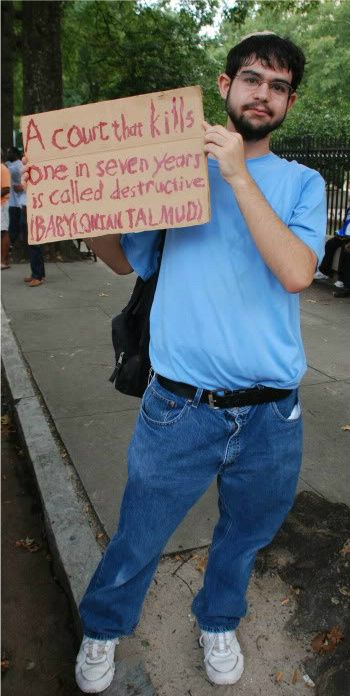Rav Rosenblum,
I read with great interest your recent article in the Jerusalem Post entitled, A Question of Governance, and I think you brought up some good points about the problems facing the Israeli economy. However, I'm wondering why you didn't delve just a little bit further into the data on the Israeli educational system.
The data from the latest Statistical Abstract of Israel seem to show that the problems in the educational system are not equally distributed.
For instance, take a look at Table 8.23, which lists the total number of students in 12th grade, how many took the bagrut exam, how many passed the bagrut exam and how many met the entrance requirements for university. There are three groups of students of whom over 50% of the 12th grade classes meet the university entrance requirements. These are Jewish students educated at state secular schools (general) [55.5%], Jewish students educated at state religious schools (Administration of Religious Education) [54.0%], and Arab Christian students [53.1%].
Now, I am not saying these numbers are terrific. The American Jewish Committee has estimated in their yearbooks (go to ajcarchives.org and download the most recent one there) that 94% of American Jews over the age of 25 have a bachelor's degree. Of course, the United States does not have exams similar to the bagrut. However, American Jews tend to do quite well on the SAT and the ACT. If you look at the list of candidates for the Presidential Scholar's Program from 2005 (the year I graduated), an award for which extremely high SAT and ACT scores determine eligibility, a highly disproportionate number are probably Jewish based on their surnames. It is especially impressive since they set the qualification bar by state to try to equalize the number of students receiving the award in each state. This puts Jews at a disadvantage, 2/3 of American Jews live in one of the 6 largest states (which make up 40% of the total population of the country) and 93% live in one of the 20 largest states (which make up 74% of the total population of the country). And it is not just "secular/assimilated Jews"; a striking 3 of the 40 or so people who were in my grade at Solomon Schechter Day School of the Raritan Valley made the cut. So to summarize, yes, Israeli students from these sectors could do better, but it's not that bad. After all, only 27% of Americans as a whole over 25 have a bachelor's degree (though that's arguably a problem for America, which is another story entirely).
However, only 31% of Muslim 12th graders and 37.1% of Druze 12th graders meet eligibility requirements for university. And only 22.7% of ultra-Orthodox 12th graders even took the bagrut exams, and a miniscule 4.7% of them met the requirements to enter university.
And it is worse than that, as not all students in the Arab sector or the ultra-Orthodox sector make it as far as 12th grade. According to Table 8.31, 7.6% of ultra-Orthodox students drop out yearly between 7th and 12th grades, as do 5% of Arab students (but only 2.1% of state secular and state religious students)
Given that the Arab sectors (in particular the Muslim Arab sector) and the ultra-Orthodox sectors have much higher birth rates than the rest of the population, these disparities may have already been responsible for the poor overall numbers mentioned in your column. More importantly, because of the high birth rates, things overall will presumably get worse if the poor performances in these sectors is not addressed.
So, to make a long story short: is there a reason as to why you left these huge disparities out? And what do you think is causing them? And what should be done about it?
Thanks in advance.
skip to main |
skip to sidebar

Protest Vigil for Troy Davis
Pages
Picture of Me

Protest Vigil for Troy Davis
Blog Archive
-
▼
2010
(94)
-
▼
January
(27)
- How Far Massachusetts Has Come on Abortion Rights
- Anti-Semitic Banker Gold-Digger Gretta Duisenberg
- Ma'an News Agency (Jan 20): Mahmoud al-Mahbuh Dies...
- Why Amtrak Hasn't Gotten Riders, and How That Will...
- You Owe Me Two Hours, Census Bureau
- All Aboard! Department of Transportation Issued "H...
- Laila Abdelaziz: Obama's Questioner about Israel i...
- A Little over 1% of DC Residents are Homeless
- Silence from European Press and "Human Rights Orga...
- Shapira and Nafa both belong in Jail
- Shmuley Boteach Comes out in Favor of Gay Marriage?
- All significant U.S. Orthodox Rabbinates Together ...
- "Tefillin Bomber" Diverts Louisville-Bound Flight ...
- Newspapers in the Google News Archive
- Real Question: How does Rav Shteinman have that ki...
- On Jared Malsin-A Look at His Past Work
- Balad Dismisses MK Said Naffaa-for contact with Le...
- Democrats Hold All 10 NOVA seats in VA Senate
- Google Considers Pulling Out of China
- NAACP hypocritical regarding 2010 Census 'Negro' C...
- Kerry Picket Errs Regarding Citizenship Question i...
- The 2010 Census: Short Forms for Everybody, and Ga...
- Haredim Should Do the Jobs 'Israelis Won't Do' Ins...
- An Open Letter to Jonathan Rosenblum
- Haredi Women Getting Abortions?
- Are Haredim Planning to Expand their Shabbos rioting?
- Bravo to the anonymous 60-year old Tear Gas (Peppe...
-
▼
January
(27)
